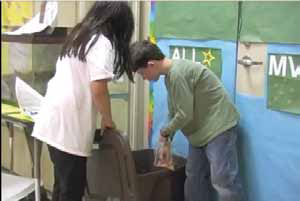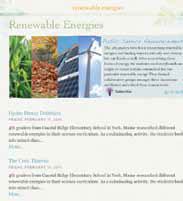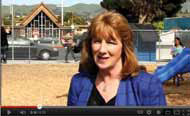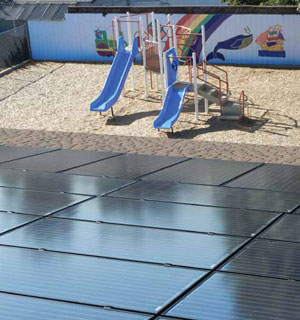Go Green to Save Green

Most schools wants to do their part to save resources — both for the environment and for shrinking budgets. A recent survey of education professionals conducted by Luidia, Inc. revealed that 91% of school leaders cite cost as a significant challenge to bringing in the new technology kids want. However, these schools not only found eco-friendly ways to save some green, they used technology to achieve it.
See what Brown(OUTS)
Can Do for You
Recent years have shown how brownouts and blackouts can severely cripple a metropolitan area when entire populations crank up their ACs at the same time. Being responsible about energy consumption during these high-risk times is a good lesson for students; getting paid for it is even better. Knox County Schools in Knoxville, TN would agree, as they worked together to decide how to spend their annual $70,000 paycheck for joining the TVAEnerNOC Demand Response Program.
Global WormingStudents “feed” their worm bins after lunch.Coastal Ridge fourthgraders in the editing room.


“When I started in 2007, energy was the largest expense after personnel,” said Knox County Schools Energy Manager Zane Foraker. “We were facing unsustainable cost increases.”
EnerNOC engineers installed free, customized interval metering and monitoring equipment, giving each school access to real-time intelligence on energy use. This not only allowed schools to accurately gauge use and cut back on costs throughout the year, but it also entered them into a program to reduce stress on the regional power grid during peak usage periods. Using this newfound data, Foraker has reduced his district’s annual energy bill by more than $2 million a year.
Dispatches are sent to the schools to alert them to adjust cooling set points or reduce unnecessary lighting for an average of four to six hours. With the earliest dispatch time set at 1pm, with a 30-minute response time, the school day is often winding down. Key personnel can log onto the DemandSMART application via their laptops, customizing the response based on current use of facilities (e.g., if a school play or assembly is underway).
Tools and ideas to transform education. Sign up below.
“We’ve found that most of our schools only rise about 1.5 degrees an hour even on the hottest days,” said Foraker. “If you don’t tell people, they don’t notice the changes.”
After a four-school pilot, Knox signed 20 more schools into the program. The annual $70,000 paycheck of unbudgeted revenue will continue to rise as they increase participation to an end goal of 72 schools.
Ditching PC’s = SavingsCubed
Woodland Joint Unified School District in Northern California slashed 90% off the cost of powering their student computer labs by ditching 300 ageing PCs for tiny, noiseless Pano Logic cubes.
Renewable Energy PSAs 2012Renewable Energy PSAs 2011Video Explaining our Project and the Shift in ThinkingMaine Recycles Commercial Contest PSAs




“It’s gratifying to see the savings adding up and to know they will continue to add up in the long term,” said Todd Freer, information technology specialist at Woodland. “Adopting cloud computing was a major accomplishment in our technology program.”
Teachers no longer have to share just one PC that scans multiple electronic Scantron answer sheets. They can now access centrally hosted scanning software through the VMware View Client installed on every teacher computer. The cubes also do not store data locally, fully eliminating endpoint security liabilities for sensitive student information.
“We needed a solution that required less maintenance, consumed less energy, and improved productivity for our IT staff,” said Joshua Koch, director of technology at Woodland. “We were able to set up in less than three weeks, and we’ve cut down the number of hours each month devoted to device support and maintenance.”
The zero-client desktop virtualization system saves both financial and natural resources. It lowers the amount of energy processed, alleviates the need for IT personnel to drive from school to school to handle maintenance issues, and reduces AC needs in labs sans PC’s hot processors and whirring fans. (In the sun bowl of California, that’s pretty cool!)
Some projects really do start from the ground up. Fourth graders at Coastal Ridge Elementary School in York, Maine, inspired by their school’s eco-friendly programs like worm bins to break down fruit and vegetable waste, wanted to produce public service announcements about renewable energies and recycling for the greater community.
“This is authentic learning at its best,” says Eric Lawson, technology integration specialist. “I taught mini-lessons using Flipcam shooting and iMovie editing. Classroom teachers prepared storyboards, scripts, and parameters for the project. [These projects] qualify for service learning within our community.”
What ’s Your SPF?
(Savings Potential Factor )Jennifer Casey, Hirsch Elementary PrincipalJim Petersen evaluates Hirsch needs.Petersen at ribbon cutting.The videos are published to the Web, aired on York’s local access television station, and are broadcast during monthly student live news programs within the school. The success and community involvement encouraged the school to broaden its environmental message (and the circle it went out to) by scrapping its paper newsletter and other handouts in favor of online documents. These efforts, combined with cutting out color printing, have saved an estimated annual $36,000 for the school while greatly reducing its carbon footprint.



Some Hirsch students helped with solar panel installation.A generous donation of a complete solar system from the Petersen Dean Roofing Company made Hirsch Elementary the first 100% solar-powered school in Fremont, California. Though the school likely enjoyed the nod from Jim Petersen (Petersen Dean’s president) due to his status as former school board member and current parent, state grant programs and system payoffs may make this a valuable prospect for other schools.

“We have been 100% solar powered since November without a glitch or a hiccup,” says Jennifer Casey, Hirsch Elementary principal. “We integrated discussion of solar energy into science lessons and labs. We also used the topic as a jump-off to explore alternate energies. It was pretty exciting for them to look out their classroom window and see the panels.”
When asked what Hirsch’s plans were for the estimated $12,000 annual savings (more than a quarter of a million dollars over 20 years), Casey confirmed that the funds were earmarked for “increasing technology and bringing more computers into the classrooms. “
Sascha has nearly two decades of experience as a freelance journalist writing for national magazines, including The Washington Post, LA Times, Christian Science Monitor, National Geographic Traveler, and others. She writes about education, travel and culinary topics.

